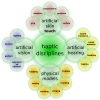A Narrative Review of Haptic Technologies and Their Value for Training, Rehabilitation, and the Education of Persons with Special Needs
- PMID: 39517844
- PMCID: PMC11548615
- DOI: 10.3390/s24216946
A Narrative Review of Haptic Technologies and Their Value for Training, Rehabilitation, and the Education of Persons with Special Needs
Abstract
Haptic technologies are increasingly valuable for human-computer interaction in its many flavors, including, of course, virtual reality systems, which are becoming very useful tools for education, training, and rehabilitation in many areas of medicine, engineering, and daily life. There is a broad spectrum of technologies and approaches that provide haptic stimuli, ranging from the well-known force feedback to subtile pseudo-haptics and visual haptics. Correspondingly, there is a broad spectrum of applications and system designs that include haptic technologies as a relevant component and interaction feature. Paramount is their use in training of medical procedures, but they appear in a plethora of systems deploying virtual reality applications. This narrative review covers the panorama of haptic devices and approaches and the most salient areas of application. Special emphasis is given to education of persons with special needs, aiming to foster the development of innovative systems and methods addressing the enhancement of the quality of life of this segment of the population.
Keywords: childhood special education; educational tools; haptic technology; learning process; pedagogical rehabilitation.
Conflict of interest statement
The authors declare no conflict of interest. The funders had no role in the design of the study; in the collection, analyses, or interpretation of data; in the writing of the manuscript; or in the decision to publish the results.All authors have read and agreed to the published version of the manuscript.
Figures




Similar articles
-
Rehabilitation of activities of daily living in virtual environments with intuitive user interface and force feedback.Disabil Rehabil Assist Technol. 2017 Oct;12(7):672-680. doi: 10.1080/17483107.2016.1218554. Epub 2016 Oct 26. Disabil Rehabil Assist Technol. 2017. PMID: 27782750
-
An Overview of Wearable Haptic Technologies and Their Performance in Virtual Object Exploration.Sensors (Basel). 2023 Feb 1;23(3):1563. doi: 10.3390/s23031563. Sensors (Basel). 2023. PMID: 36772603 Free PMC article. Review.
-
Pseudo-haptics and self-haptics for freehand mid-air text entry in VR.Appl Ergon. 2022 Oct;104:103819. doi: 10.1016/j.apergo.2022.103819. Epub 2022 Jun 7. Appl Ergon. 2022. PMID: 35687993
-
Effectiveness of haptic feedback devices in preclinical training of dental students-a systematic review.BMC Oral Health. 2023 Oct 10;23(1):739. doi: 10.1186/s12903-023-03410-3. BMC Oral Health. 2023. PMID: 37817151 Free PMC article.
-
A narrative review on haptic devices: relating the physiology and psychophysical properties of the hand to devices for rehabilitation in central nervous system disorders.Disabil Rehabil Assist Technol. 2013 May;8(3):181-9. doi: 10.3109/17483107.2012.697532. Epub 2012 Jul 16. Disabil Rehabil Assist Technol. 2013. PMID: 22794937 Review.
References
-
- Cantoni V., Cellario M., Porta M. Perspectives and challenges in e-learning: Towards natural interaction paradigms. J. Vis. Lang. Comput. 2004;15:333–345. doi: 10.1016/j.jvlc.2003.10.002. - DOI
-
- Papanastasiou G., Drigas A., Skianis C., Lytras M., Papanastasiou E. Virtual and augmented reality effects on K-12, higher and tertiary education students’ twenty-first century skills. Virtual Real. 2019;23:425–436. doi: 10.1007/s10055-018-0363-2. - DOI
-
- Donmez M. A systematic literature review for the use of eye-tracking in special education. Educ. Inf. Technol. 2023;28:6515–6540. doi: 10.1007/s10639-022-11456-z. - DOI
-
- Lewis-Dagnell S., Parsons S., Kovshoff H. Creative methods developed to facilitate the voices of children and young people with complex needs about their education: A systematic review and conceptual analysis of voice. Educ. Res. Rev. 2023;39:100529. doi: 10.1016/j.edurev.2023.100529. - DOI
-
- Álvarez-Ariza J., Baez H. Understanding the role of single-board computers in engineering and computer science education: A systematic literature review. Comput. Appl. Eng. Educ. 2021;30:304–329. doi: 10.1002/cae.22439. - DOI
Publication types
MeSH terms
LinkOut - more resources
Full Text Sources

